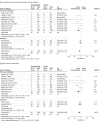Routine Ultrasonography Guidance for Femoral Vascular Access for Cardiac Procedures: The UNIVERSAL Randomized Clinical Trial
- PMID: 36116089
- PMCID: PMC9483833
- DOI: 10.1001/jamacardio.2022.3399
Routine Ultrasonography Guidance for Femoral Vascular Access for Cardiac Procedures: The UNIVERSAL Randomized Clinical Trial
Abstract
Importance: A significant limitation of femoral artery access for cardiac interventions is the increased risk of vascular complications and bleeding compared with radial access. Strategies to make femoral access safer are needed.
Objective: To determine whether routinely using ultrasonography guidance for femoral arterial access for coronary angiography/intervention reduces bleeding or vascular complications.
Design, setting, and participants: The Routine Ultrasound Guidance for Vascular Access for Cardiac Procedures (UNIVERSAL) randomized clinical trial is a multicenter, prospective, open-label trial of ultrasonography-guided femoral access vs no ultrasonography for coronary angiography or intervention with planned femoral access. Patients were randomized from June 26, 2018, to April 26, 2022. Patients with ST-elevation myocardial infarction were not eligible.
Interventions: Ultrasonography guidance vs no ultrasonography guidance for femoral arterial access on a background of fluoroscopic landmarking.
Main outcomes and measures: The primary composite outcome is the composite of major bleeding based on the Bleeding Academic Research Consortium 2, 3, or 5 criteria or major vascular complications within 30 days.
Results: A total of 621 patients were randomized at 2 centers in Canada (mean [SD] age, 71 [10.24] years; 158 [25.4%] female). The primary outcome occurred in 40 of 311 patients (12.9%) in the ultrasonography group vs 50 of 310 patients (16.1%) without ultrasonography (odds ratio, 0.77 [95% CI, 0.49-1.20]; P = .25). The rates of Bleeding Academic Research Consortium 2, 3, or 5 bleeding were 10.0% (31 of 311) vs 10.7% (33 of 310) (odds ratio, 0.93 [95% CI, 0.55-1.56]; P = .78). The rates of major vascular complications were 6.4% (20 of 311) vs 9.4% (29 of 310) (odds ratio, 0.67 [95% CI, 0.37-1.20]; P = .18). Ultrasonography improved first-pass success (277 of 311 [86.6%] vs 222 of 310 [70.0%]; odds ratio, 2.76 [95% CI, 1.85-4.12]; P < .001) and reduced the number of arterial puncture attempts (mean [SD], 1.2 [0.5] vs 1.4 [0.8]; mean difference, -0.26 [95% CI, -0.37 to -0.16]; P < .001) and venipuncture (10 of 311 [3.1%] vs 37 of 310 [11.7%]; odds ratio, 0.24 [95% CI, 0.12-0.50]; P < .001) with similar times to access (mean [SD], 114 [185] vs 129 [206] seconds; mean difference, -15.1 [95% CI, -45.9 to 15.8]; P = .34). All prerandomization prespecified subgroups were consistent with the overall finding.
Conclusions and relevance: In this randomized clinical trial, use of ultrasonography for femoral access did not reduce bleeding or vascular complications. However, ultrasonography did reduce the risk of venipuncture and number of attempts. Larger trials may be required to demonstrate additional potential benefits of ultrasonography-guided access.
Trial registration: ClinicalTrials.gov Identifier: NCT03537118.
Conflict of interest statement
Figures



Comment in
-
Fluoroscopic Guidance for Femoral Artery Access-Pushing Patients Out of the Plane Without a Parachute?JAMA Cardiol. 2022 Nov 1;7(11):1118-1120. doi: 10.1001/jamacardio.2022.3413. JAMA Cardiol. 2022. PMID: 36116072 No abstract available.
References
Publication types
MeSH terms
Associated data
LinkOut - more resources
Full Text Sources
Medical
Miscellaneous

